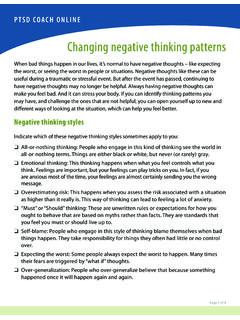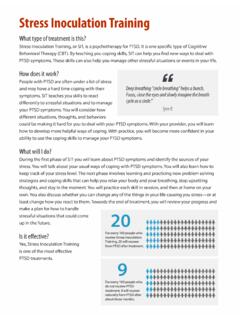Transcription of CLASSIFICATION OF TRAUMA AND STRESSOR-RELATED …
1 DEPRESSION AND ANXIETY 28: 737-749 (2011)Review CLASSIFICATION OF TRAUMA AND STRESSOR-RELATED DISORDERS IN DSM-5 Matthew J. Friedman, ,1,2 Patricia A. Resick, ,3,4 Richard A. Bryant, ,5 James Strain, ,6 Mardi Horowitz, ,7 and David Spiegel, ,* This review examines the question of whether there should be a cluster of disorders, including the adjustment disorders (ADs), acute stress disorder (ASD), posttraumatic stress disorder (PTSD), and the dissociative disorders (DDs), in a section devoted to abnormal responses to stress and TRAUMA in the DSM-5. Environmental risk factors, including the individual's developmental experience, would thus become a major diagnostic consideration. The relationship of these disorders to one another is examined and also their relationship to other anxiety disorders to determine whether they are better grouped with anxiety disorders or a new specific grouping of TRAUMA and STRESSOR-RELATED disorders.
2 First how stress responses have been classified since DSM-III is reviewed. The major focus is on PTSD because it has received the most attention, regarding its proper placement among the psychiatric diagnoses. It is discussed whether PTSD should be considered an anxiety disorder, a stressinduced fear circuitry disorder, an internalizing disorder, or a TRAUMA and STRESSOR-RELATED disorder. Then, ASD, AD, and DD are considered from a similar perspective. Evidence is examined pro and con, and a conclusion is offered recommending inclusion of this cluster of disorders in a section entitled " TRAUMA and STRESSOR-RELATED Disorders." The recommendation to shift ASD and PTSD out of the anxiety disorders section reflects increased recognition of TRAUMA as a precipitant, emphasizing common etiology over common phenomenology. Similar considerations are addressed with regard to AD and DD.
3 Depression and Anxiety 28:737-749, 2011. 2011 Wiley-Liss, Inc. Key words: TRAUMA ; stress; stressor; dissociation; dissociative disorders; anxiety disorders; adjustment disorders; PTSD; ASD; posttraumatic stress disorderINTRODUCTION Should the DSM-5 include a section on Disorders Related to Environmental (Traumatic and Other) Stressors, ranging in severity from adjustment disorders *Correspondence to: David Spiegel, Department of Psychiatry, Stanford University School of Medicine, Stanford, California. E-mail: The authors report they have no financial relationships within the past 3 years to disclose. Received for publication 4 February 2011; Revised 28 April 2011; Accepted 4 May 2011 DOI Published online 16 June 2011 in Wiley Online Library (wiley ).1=National Center for PTSD, US Department of Veteran Affairs, VA Medical Center, White River Junction, Vermont 2 =Departments of Psychiatry and Pharmacology & Toxicology, Dartmouth Medical School, Hanover, New Hampshire 3 =VA Center for National Center for PTSD, White River Junction, Vermont 4=Boston University, Boston, Massachusetts 5 =School of Psychology, University of New South Wales, Sydney, Australia 6 =Department of Psychiatry, Mt Sinai School of Medicine, New York, New York 7 =Department of Psychiatry, University of California, San Francisco, California 8 =Department of Psychiatry and Behavioral Sciences, Stanford, California 2011 Wiley-Liss, Friedman et al.
4 (ADs) to acute stress disorder (ASD), posttraumatic stress disorder (PTSD), and dissociative disorders (DDs)? Currently, these possibly related disorders are classified under different categories in DSM-IV (anxiety disorders, DDs, and ADs). This review examines the spectrum of stress-related and posttraumatic and symptomatology, the relatedness of these disorders, and how they might be classified in DSM-5 under a heading as TRAUMA and STRESSOR-RELATED Disorders. This review emphasizes that there is both clinical utility and heuristic value in clustering specific diagnoses within broad diagnostic categories. Such a method of CLASSIFICATION enables clinicians to distinguish one diagnosis from another, despite overlapping symptoms or clinical presentations. Broad diagnostic categories also generate testable theoretical explanations for specific groups of psychiatric disorders which can be systematically evaluated in research.
5 The hypothesized stress-induced fear-circuitry disorders, and dissociative subtype of PTSD, discussed below, are good examples of how laboratory results with neuroimaging suggest a distinct CLASSIFICATION scheme for some, but not all, anxiety disorders. BACKGROUND Poets, dramatists, and novelists ( , Homer, Shakespeare, Dickens) were the first to record the profound impact of traumatic stressors on cognitions, feelings, and behavior. Medicalization of such invisible wounds began during the mid-Nineteenth Century on both sides of Atlantic during the American Civil and Franco-Prussian Wars. Psychological TRAUMA among civilians was most conspicuous following train accidents and became known as "Railway Spine." Such syndromes have embodied many, if not all, current PTSD symptoms although a variety of explanatory models have been invoked to account for such clinical observations.
6 Some explanations focused on the heart ( , soldier's heart, Da Costa's syndrome, neurocirculatory asthenia); others on the nervous system ( , railway spine, shell shock) and others on the psyche ( , nostalgia, traumatic neurosis). From a theoretical perspective different explanatory models for these various syndromes have been derived from: psychoanalytic theory, Pavlovian fear conditioning models, Mowrer's two factor theory, Selye's theories of stress and adaptation, Horowitz's information processing cognitive-dynamic theories, cognitive theories, and neurobiology. [1-3] By contrast, earlier editions of the DSM were steadfastly descriptive and atheoretical, presumably as a reaction against psychodynamic theorizing about the etiology of psychopathology, and to gain a greater opportunity for reliability in the diagnostic process. The One necessary exception was posttraumatic stress disorder, because it was by definition caused, at least in part, by exposure to a traumatic stressor.
7 (Other exceptions included the, AD (which required a morethan normal response to a stressor), organic mental disorders, and substance abuse disorders, where the etiological agent was specified.) Of course, like the etiology of any disorder, biopsychosocial factors combine, and traumatic events have an impact based on preexisting neural, genetic, personality, and contextual factors, including prior identity and relationship capacities and attitudes. Some would like to base most diagnoses, even PTSD, upon genetic, developmental, and personality differences,[4,5] although data suggest that the severity and frequency of TRAUMA exposure is the most important variable.[61 Clearly, the underlying premise is that there are a variety of pathological responses to exposure to a range of stressors, from mild to severe and traumatic, and there is some association between the severity of the stressor, the individual stressed, and the nature of the response.]
8 [71 Therefore, it makes sense to consider a grouping of disorders within DSM-5 that ranges from adjustment through acute and posttraumatic stress disorders, and possibly others that constitute the range of reactions to environmental stressors. (This is not to say that onset of a depressive or anxiety disorder episode may not be preceded by exposure to stress, but a specified stressor does not constitute a required criterion for the diagnosis). It is noted that a specified stressor is also not required for DD; however, these conditions often exist following adverse experiences, and so the merits and limitations of including DD along with PTSD, ASD, and AD in this diagnostic cluster are considered. This issue is addressed later. HISTORY OF DSM AND STRESS RESPONSES In DSM-I,[8] "gross stress reaction" was an illdefined diagnosis for classifying individuals who had been psychologically altered by exposure to military or civilian experiences.]
9 It was a useful diagnosis for initially classifying military veterans, ex-prisoners of war, rape victims, and Nazi Holocaust survivors. From a DSM-III[9] perspective, however, the major problem was that gross stress reaction was considered a "temporary diagnosis" which would be changed to a "neurotic reaction" if the condition persisted. DSM-II [10] eliminated this diagnosis, leaving practitioners with no diagnostic option by which to classify clinically significant and persistent reactions to catastrophic experiences. "Situational Reaction" was the only diagnostic alternative. Because it included the full spectrum of adverse events from traumatic events to unpleasant experiences, it was seen as trivializing the impact of traumatic exposure. Furthermore, as with the DSM-I gross stress reaction, it was also considered a temporary and reversible clinical condition.
10 By the midto-late 1970s many mental health clinicians recognized the need for a new diagnosis for patients suffering from severe, chronic and sometimes irreversible syndromesDepression and AnxietyReview: TRAUMA - and STRESSOR-RELATED Disorders in DSM-5 739following exposure to catastrophic events. Although not included in DSM-II, a number of syndromes had been described in the professional literature by that time, all named after the traumatic event itself such as: rape TRAUMA syndrome, post-Vietnam syndrome, prisonerof-war syndrome, concentration camp syndrome, war sailor syndrome, child abuse syndrome, battered women's syndrome, etc. The exciting new formulation that emerged during the DSM-III process[9] was that all of these discrete syndromes could be adequately characterized by the specific symptoms proposed in the PTSD diagnostic criteria. There have been some alterations of the original DSM-III[9] PTSD criteria.











